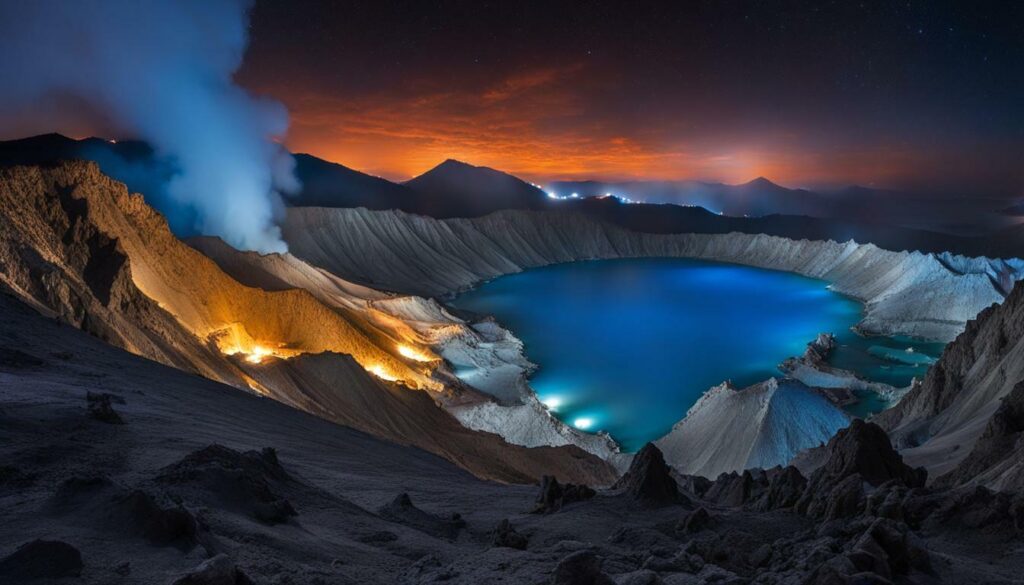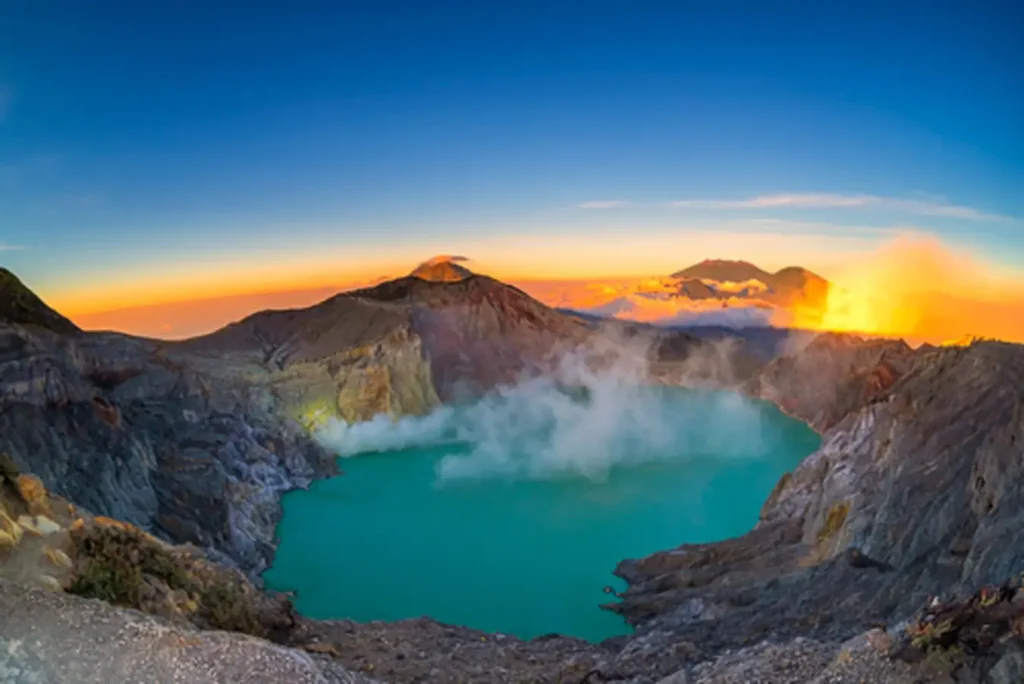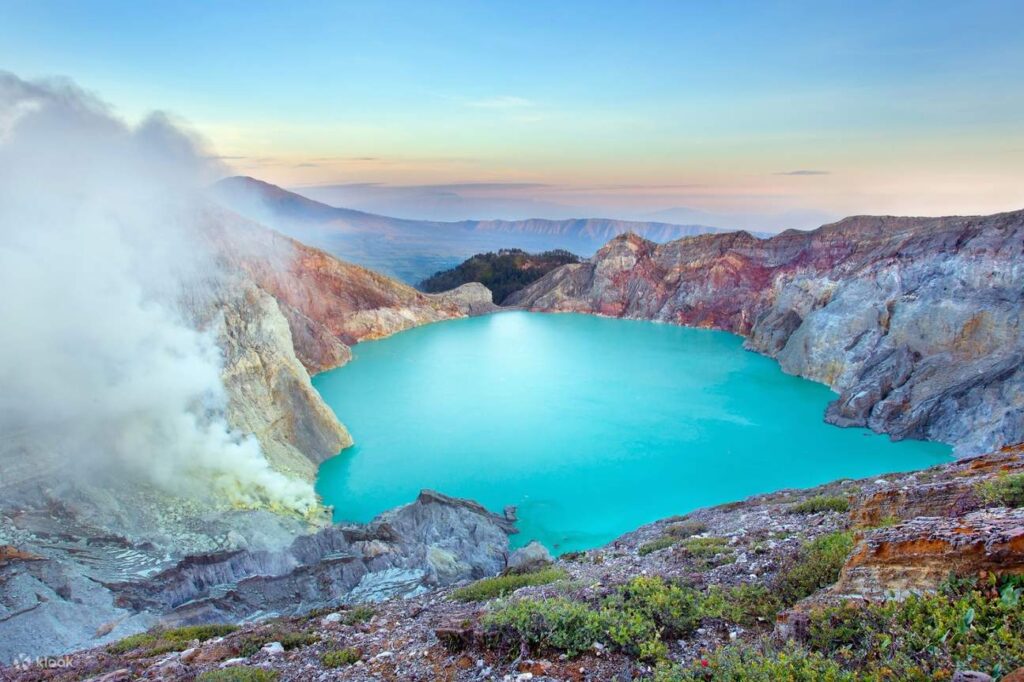If you’re looking for an adventure that combines stunning natural beauty with fascinating geological wonders, then Kawah Ijen should be on your must-visit list. Located on the eastern side of Java island in Indonesia, this active volcano is a popular tourist attraction, drawing visitors from around the globe.
At Kawah Ijen, you’ll find a mesmerizing turquoise crater lake, sulfuric gas vents, and the rare phenomenon of blue fire. But the beauty of this volcano isn’t just skin-deep; it also holds cultural significance for the local people.
In this article, we’ll take a deep dive into the wonders of Kawah Ijen, from its unique features and cultural heritage to the opportunities for hiking and trekking in the area. We’ll also explore other nearby destinations in East Java and provide practical tips for planning your visit.
Key Takeaways:
- Kawah Ijen is an active volcano located on the eastern side of Java island in Indonesia.
- The volcano boasts many unique features, including a stunning turquoise crater lake, sulfuric gas vents, and the rare phenomenon of blue fire.
- Visitors can enjoy hiking and trekking opportunities in the area, as well as exploring other nearby destinations in East Java.
- Kawah Ijen holds cultural significance for the local people, and visitors are encouraged to learn about and respect the cultural heritage.
- When planning your visit, be sure to consider transportation options, best times to visit, entry fees, and safety tips for responsible tourism.
Exploring the Magnificent Crater Lake at Kawah Ijen
One of the most breathtaking features of Kawah Ijen is its stunning crater lake. Located at the top of the volcano, the turquoise-colored lake is a sight to behold. The unique color is due to the high acidity of the water, caused by the sulfuric gases underlying the lake.
Formed through volcanic activity, the crater lake is around 200 meters deep and spans an area of more than 0.4 square kilometers. Its location at the top of the volcano offers a panoramic view of the surrounding landscape, making it a popular spot for visitors to capture stunning photos.
The best time to visit the crater lake is during the early morning, when the sun is rising and the lake is shrouded in mist. This creates a surreal and mystical atmosphere, with the lake appearing like a hidden gem amidst the clouds.
Fun fact: The crater lake at Kawah Ijen is recognized as the largest acidic lake in the world. Its unique characteristics have made it a popular subject of scientific research on volcanic lakes.
Witnessing the Phenomenal Blue Fire of Kawah Ijen
One of the most awe-inspiring natural phenomena at Kawah Ijen is the blue fire. This rare occurrence is a result of ignited sulfuric gases that escape from cracks in the volcano’s surface. The blue flames can reach up to 5 meters in height, creating a surreal and mesmerizing sight.
The best time to witness the blue fire is during the night, from midnight to dawn. Visitors can embark on a guided hike to the crater rim to observe this incredible display. However, it is crucial to follow safety guidelines and wear appropriate gear, including gas masks and sturdy shoes, as the trails can be steep and slippery.
It is essential to note that the blue fire phenomenon is not always visible, and its intensity can vary depending on the weather and other factors. Therefore, visitors should check with the local authorities and tour operators before planning their trip.
Sulfur Mining at Kawah Ijen: A Glimpse into a Challenging Profession
Kawah Ijen is not only a stunning natural attraction, but it is also the site of a unique industry – sulfur mining. The sulfur deposits at the volcano have been mined by locals for centuries, providing much-needed income for their families.
The process of sulfur mining at Kawah Ijen is extremely challenging and requires great physical strength. Miners descend into the crater and use basic tools to break up large sulfur rocks. They then carry baskets filled with up to 100 kilograms of sulfur up steep slopes, enduring toxic fumes and extreme heat along the way.
Sulfur mining at Kawah Ijen is not only physically demanding but also carries significant health risks. The toxic fumes in the crater can cause respiratory problems and skin irritation, and the heavy loads of sulfur can cause long-term damage to the miners’ backs and joints.
Despite the challenges, sulfur mining remains a crucial source of income for many families in the region. While visiting Kawah Ijen, you may have the opportunity to witness the miners in action and gain a deep appreciation for their hard work and perseverance.
It is important to note that visitors should respect the miners and their work, refraining from taking photos without permission or interfering with the mining process. It’s also essential to exercise caution when visiting the sulfur mines and follow safety guidelines for a safe and enjoyable experience.
Hiking and Trekking Adventures to Kawah Ijen
For adventurous travelers, hiking and trekking opportunities abound at Kawah Ijen. The volcano offers stunning views and unique geological features that make for an unforgettable experience. Here are some things to keep in mind when planning your hiking or trekking adventure at Kawah Ijen.
Trails
Kawah Ijen offers several trails of varying difficulty levels. The most popular and scenic route is the 3-kilometer hike to the rim of the crater. The trail is moderately challenging, with inclines and rocky terrain, but the views along the way are unparalleled. For more experienced hikers, there is a longer and more strenuous trek that takes you down into the crater, where you can witness the blue fire up close.
Gear
Proper gear is essential for a safe and enjoyable hike or trek at Kawah Ijen. Be sure to wear sturdy hiking boots with good traction and ankle support. Dress in layers, as the temperature can fluctuate, and bring a waterproof jacket in case of rain. Sunscreen, a hat, and sunglasses are also recommended, as the sun can be intense. Finally, bring plenty of water and a snack to keep you energized along the way.
Planning Your Visit
It is best to plan your visit to Kawah Ijen during the dry season, which runs from April to October. The blue fire is visible at night, so you may want to plan an overnight trip to witness this stunning natural phenomenon. Keep in mind that the hike can take anywhere from one to three hours, depending on the trail you choose and your level of fitness. It is recommended to start early in the morning to avoid crowds and to have enough time to complete the hike.
Overall, a hiking or trekking adventure at Kawah Ijen is sure to be a highlight of your visit to East Java. Be sure to come prepared and follow safety guidelines to ensure a safe and memorable experience.
East Java Tourism: Exploring Beyond Kawah Ijen
While Kawah Ijen is undoubtedly a must-visit destination in East Java, there are plenty of other attractions to explore in the region. Here are some suggestions for extending your trip and making the most out of your vacation:
Mount Bromo
One of the most famous natural wonders in Indonesia, Mount Bromo is an active volcano that attracts thousands of visitors every year. Located in the Bromo Tengger Semeru National Park, the volcano offers breathtaking views and hiking opportunities. Visitors can witness the sunrise over the crater from several viewpoints, such as Penanjakan Hill or Kingkong Hill.
Malang
A charming city located in the highlands of East Java, Malang offers a glimpse into the Dutch colonial era of Indonesia. The city boasts many historical buildings, such as the Jami Mosque and the Dutch-era City Hall. There are also several natural attractions nearby, such as the beach of Balekambang or the waterfall of Coban Rondo.
Banyuwangi
A gateway to many natural attractions in East Java, Banyuwangi is a city on the easternmost tip of the island. Visitors can explore the stunning beaches of Pulau Merah or G-Land, the forests of Alas Purwo National Park, or the Ijen Plateau, which offers a different perspective of the Kawah Ijen volcano. Banyuwangi is also known for its traditional arts and crafts, such as batik and weaving.
Surabaya
The second-largest city in Indonesia, Surabaya is a bustling metropolis that combines modernity and tradition. Visitors can explore the old town of Kota, which is home to several historical landmarks, such as the House of Sampoerna or the Cheng Hoo Mosque. There are also many shopping and dining options in Surabaya, such as the Tunjungan Plaza or the famous rawon beef soup.
These are just some of the many destinations that East Java has to offer. Whether you are looking for nature, culture, or urban experiences, there is something for everyone in this diverse region of Indonesia.
The Cultural Significance of Kawah Ijen
For the local communities surrounding Kawah Ijen, the volcano holds a significant cultural and spiritual value. According to folklore, the volcano is inhabited by spirits that guard the sulfur deposit and maintain the balance of nature in the region.
The local communities offer rituals and offerings to the spirits of Kawah Ijen, seeking their blessing and protection for a successful sulfur mining season. The miners, too, often perform their own rituals before and after descending into the crater, seeking protection from the hazards of their challenging work.
Visitors to Kawah Ijen are encouraged to respect and learn about the cultural heritage of the area. It is recommended to hire a local guide who can share their knowledge and insights into the traditions and beliefs surrounding the volcano. Visitors should avoid disturbing any offerings or performing any actions that could disrespect the spirits of the volcano.
Planning Your Visit to Kawah Ijen
If you’re planning a trip to East Java, a visit to Kawah Ijen is a must on your itinerary. Here are some practical tips to help you plan your visit:
Getting There
The nearest airport to Kawah Ijen is Banyuwangi Airport, which has domestic flights from major cities in Indonesia. You can also arrive by train or bus from Surabaya or Bali. From Banyuwangi, you can take a taxi or rent a car to travel to the Ijen Plateau.
Best Time to Visit
The best time to visit Kawah Ijen is during the dry season, which runs from June to September. It is recommended to arrive early in the morning, around 2 AM to witness the blue fire phenomenon, and to avoid the crowds and heat later in the day.
Entry Fees
To enter Kawah Ijen, visitors must pay an entrance fee of IDR 100,000 (approximately USD 7) per person. The fee also includes a compulsory guide for safety reasons.
Duration of Stay
Plan to spend at least one full day at Kawah Ijen to fully explore and experience its wonders. However, if you want to take on a trekking adventure to nearby mountains or explore other tourist attractions in East Java, consider extending your stay.
Safety Tips
Take safety precautions when visiting Kawah Ijen, especially when observing the blue fire and sulfur mining activities. It is recommended to wear a mask to protect your lungs from the sulfuric gases and to keep a safe distance from the mining areas. Follow the guidance of your guide, stay on designated trails, and don’t touch or disturb the natural surroundings.
Responsible Tourism
Be a responsible tourist and help preserve the natural environment and cultural heritage of Kawah Ijen. Avoid littering, respect the locals and their traditions, and don’t support unethical tourism practices such as wildlife exploitation or child labor.
Conclusion
Kawah Ijen is a mystical volcano that offers a unique and awe-inspiring experience for visitors. From the mesmerizing turquoise crater lake to the rare blue fire phenomenon, every aspect of Kawah Ijen is fascinating.
If you’re planning a trip to East Java, Kawah Ijen should definitely be on your itinerary. However, it’s essential to be responsible while visiting and ensure that you respect the local culture and environment.
Preserving the Cultural Heritage
As you explore Kawah Ijen and its surroundings, it’s crucial to be mindful of the cultural significance of the area. The volcano holds immense value for the local communities, steeped in beliefs, folklore, and rituals that have been passed down over generations.
Therefore, it’s essential to respect the customs and traditions while visiting. Avoid disturbing any religious or cultural practices and ensure that you don’t leave any litter or damage the natural ecosystem.
Responsible Tourism
As a responsible traveler, it’s crucial to minimize your impact on the environment and the local community. Ensure that you follow the established guidelines and rules at the volcano and avoid any behavior that may harm the ecosystem.
Additionally, consider booking a tour or hiring a local guide to ensure that you receive accurate information and support the local economy. By being responsible while visiting Kawah Ijen, you can make a positive impact and preserve the beauty of this natural wonder for generations to come.
Overall, Kawah Ijen is a must-visit destination that offers a unique and immersive experience for travelers. With its stunning natural beauty, rich cultural heritage, and diverse opportunities for adventure, it’s no wonder that this mystical volcano attracts thousands of visitors each year.
So, plan your visit carefully, be respectful of the local culture, and enjoy the wonders of Kawah Ijen for a trip that you’ll never forget.
FAQ
What makes Kawah Ijen volcano in Indonesia unique?
Kawah Ijen is known for its mystical features, including the mesmerizing blue fire, stunning crater lake, and its significance as a tourist attraction in East Java.
What can I expect to see at the crater lake of Kawah Ijen?
The crater lake at Kawah Ijen is a magnificent sight with its turquoise color. It is formed due to geological processes and offers a mesmerizing view for visitors.
What is the phenomenon of the blue fire at Kawah Ijen?
The blue fire at Kawah Ijen is a rare occurrence caused by ignited sulfuric gases. It is best witnessed during the nighttime. Safety precautions and recommended viewing spots are provided for visitors.
Can you tell me more about sulfur mining at Kawah Ijen?
Sulfur mining is a challenging profession undertaken at Kawah Ijen. Miners extract sulfur from the volcano, showcasing the arduous process, the challenges they face, and the importance of sulfur mining in the local economy.
What hiking and trekking opportunities are available at Kawah Ijen?
Kawah Ijen offers various hiking and trekking trails with different difficulty levels. Visitors are provided with information on recommended gear, safety tips, and planning their hike or trek to ensure an enjoyable experience.
Are there other tourist attractions near Kawah Ijen in East Java?
East Java offers other tourist attractions apart from Kawah Ijen, such as Mount Bromo and Malang. These destinations provide unique experiences, and recommendations for accommodations and transportation options are shared.
What is the cultural significance of Kawah Ijen?
Kawah Ijen holds cultural significance for the local communities with its beliefs, folklore, and rituals. Visitors are encouraged to respect and preserve this cultural heritage while exploring the volcano.
How can I plan my visit to Kawah Ijen?
Practical information for planning a visit to Kawah Ijen is provided, including transportation options, best times to visit, entry fees, recommended duration of stay, safety tips, and guidelines for responsible tourism.





